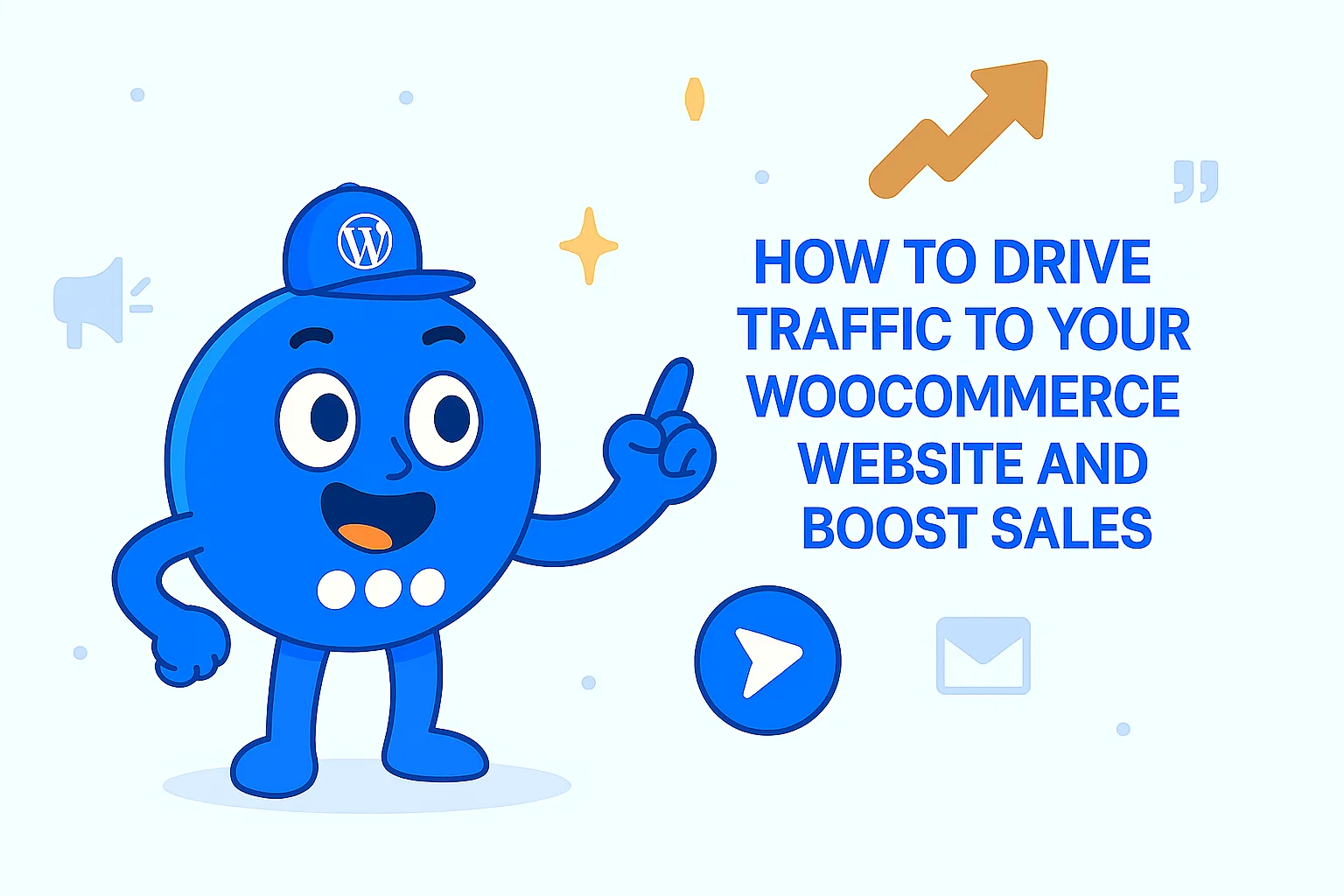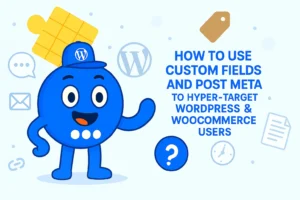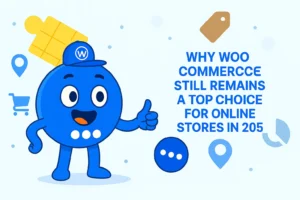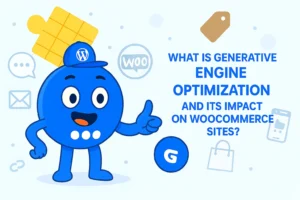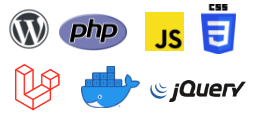How to Drive Traffic to Your WooCommerce Website and Boost Sales
Introduction: Your WooCommerce Journey Starts Here
Setting the Stage: Why Traffic and Sales Matter for Your Online Store
For any online business, traffic serves as the essential lifeblood, bringing potential customers directly to a digital storefront. When individuals search for products online, they use diverse phrases, making it crucial for a WooCommerce store to be easily discoverable by its target audience. However, merely attracting visitors is not enough; the ultimate objective is to convert those visitors into paying customers. The initial step towards achieving robust conversions involves creating widespread awareness for the products and brand.
The true power of an online store lies in its ability to optimize the entire customer journey, turning more visitors into buyers, often without the need for additional spending on acquiring new traffic. This necessitates a balanced and comprehensive strategy where both traffic generation and conversion optimization are interdependent and equally prioritized.
Traffic brings the opportunity, but conversion realizes the revenue. A high volume of visitors to a poorly optimized site represents a significant missed opportunity, as these potential customers may leave without purchasing. Conversely, a perfectly optimized site with no visitors will generate no sales. Therefore, sustainable and profitable growth in the e-commerce landscape demands a holistic approach that seamlessly integrates efforts to attract visitors with strategies to guide them efficiently towards a purchase.
Part 1: Attracting Your Ideal Customers (Driving Traffic)
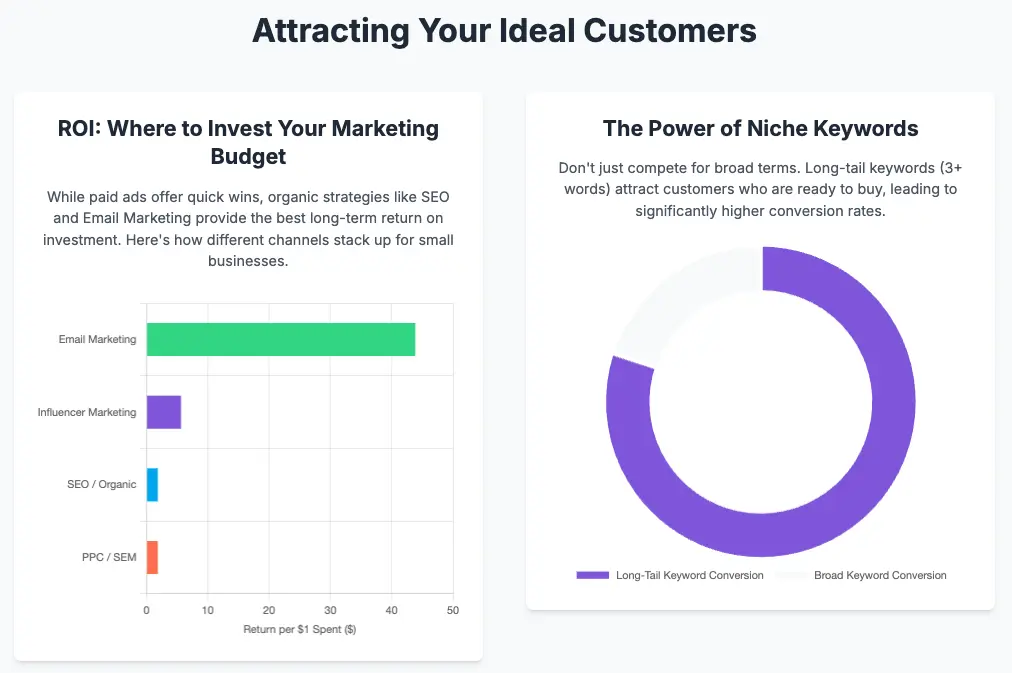
Chapter 1: Mastering Organic Traffic: The Power of SEO & Content
Getting Found: WooCommerce SEO Essentials
To ensure a WooCommerce store stands out in the vast digital marketplace, mastering Search Engine Optimization (SEO) is paramount. This involves making the website appealing to search engines like Google, which in turn helps potential customers find the products they are looking for.
Keywords That Convert: Finding What Your Customers Search For
Keywords are the specific phrases potential customers type into search engines when looking for products or information. Optimizing a WooCommerce store for relevant keywords is crucial for attracting the right audience—individuals who are genuinely interested in what is offered. To identify the most effective keywords for a particular niche, various tools can be employed, such as Semrush or Google’s Keyword Planner. Analyzing the keywords that competitors are successfully ranking for can also provide valuable inspiration for a store’s own targeting strategy.
A particularly powerful strategy involves focusing on long-tail keywords. These are more specific, multi-word phrases (e.g., “organic fair-trade coffee beans for espresso machines” instead of just “coffee beans“).
While individual long-tail keywords may have lower search volumes, they often capture higher user intent, leading to conversion rates that are 3 to 5 times better than broader, shorter keywords. For small WooCommerce businesses, this offers a significant strategic advantage in competitive markets.
Competing for highly competitive, short-tail keywords often requires substantial domain authority and larger advertising budgets. Long-tail keywords, by contrast, attract users who are further along in their purchasing journey and have a clearer idea of what they want. This often results in less competition, potentially lower advertising costs , and a higher likelihood of conversion. Therefore, for smaller WooCommerce stores, a targeted, niche-focused keyword strategy is frequently more effective and resource-efficient than a broad, high-volume approach.
Optimizing Your Store Pages: Titles, Descriptions, URLs, and Images
Once relevant keywords have been identified, the next step is to strategically integrate them throughout the WooCommerce store’s pages. This process extends beyond simply listing keywords; it involves crafting every element to be both search-engine friendly and highly engaging for human visitors.
Product Titles & Descriptions: Crafting SEO-friendly product titles and descriptions is essential, as these are often the first elements users see in search results. They must incorporate relevant keywords, provide clear product information, and align with the user’s search intent. A compelling title and description should be unique, engaging, and include a strong call to action to encourage clicks. You can check this article The Ultimate Guide to Writing High-Converting WooCommerce Product Descriptions to learn more how to write good product description.
URLs/Permalinks: The URLs of pages, also known as permalinks, should be optimized to be short, simple, and contain relevant keywords. It is recommended to avoid special characters and common “stop words” like “and,” “the,” or “of,” using hyphens to separate words for readability. Maintaining a consistent URL structure across all products, categories, and other pages is also important for clarity and SEO.
Images: Product images offer a significant opportunity to attract traffic, especially from image searches. To leverage this, descriptive “Alt Text” should be added to all product images, incorporating relevant keywords. Beyond SEO, images must be compressed using tools like TinyPNG or ShortPixel to ensure fast loading times without compromising visual quality.
Category Pages: Category pages should be given clear, descriptive names that include relevant keywords, such as “women’s running shoes” instead of just “shoes”. Writing unique and engaging descriptions for these pages, along with incorporating internal links to connect related products and categories, can significantly improve navigation and search engine optimization.
These individual on-page optimization tasks are not isolated efforts; they form a cohesive ecosystem. When all elements—titles, descriptions, URLs, and images—are optimized consistently with relevant keywords and a clear understanding of user intent, they reinforce each other. This sends stronger, more coherent signals to search engines and simultaneously creates a more compelling, trustworthy experience for users. This integrated approach amplifies the effect of each individual optimization, leading to higher search rankings and improved click-through rates.
The Speed Advantage: Why a Fast Site Wins (and How to Get One)
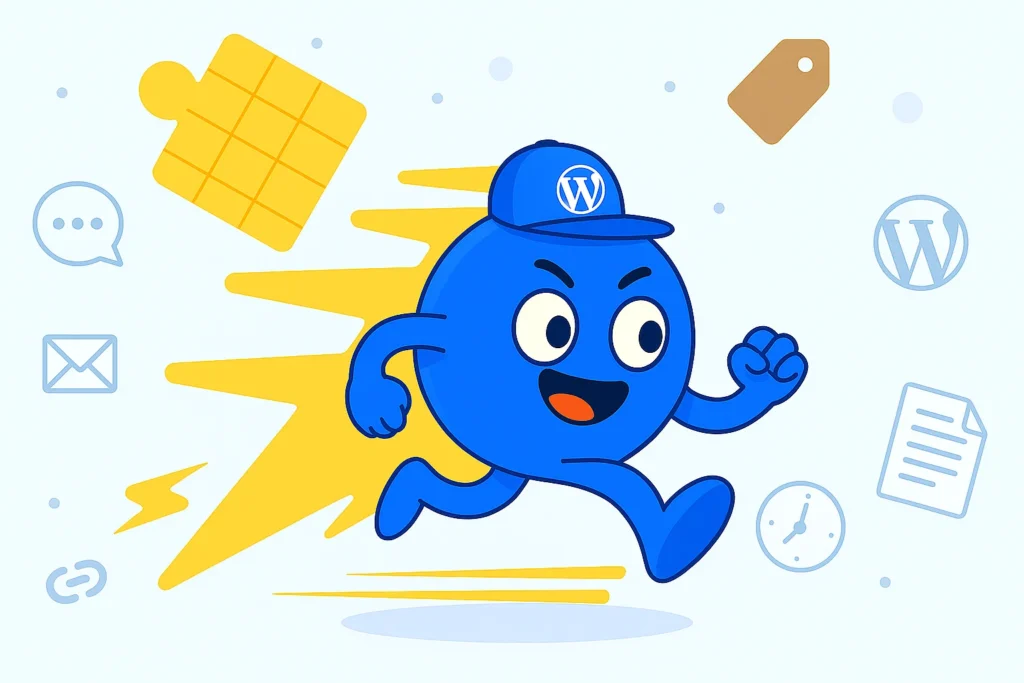
Site speed is a critical factor for both search engine rankings and user experience. An ideal goal is to achieve a load time of three seconds or less. When a website is slow, it frustrates visitors and signals a lack of professionalism, leading to higher bounce rates and lost conversions. Therefore, optimizing site speed is a crucial investment in customer experience and brand reputation.
Several key optimization steps can significantly improve a WooCommerce store’s loading speed:
- Image Optimization: Use image-based content in moderation, and always compress images to reduce their file size without impacting quality. Implementing lazy loading, where images only render when a user scrolls over them, can also significantly shorten page load times.
- Caching: Enable browser caching and object caching to store cached versions of website pages or database query results in local memory or on the server side. This reduces the need to repeatedly execute queries, leading to quicker loads when pages are revisited. Popular plugins like WP Rocket, WP Fastest Cache, WP Super Cache, and W3 Total Cache can assist with this.
- Content Delivery Network (CDN): Utilizing a CDN helps deliver static content from servers geographically closest to users, thereby reducing data travel distance and speeding up loading times.
- Plugin Management: Regularly review and remove unnecessary or unused plugins, as they can slow down a site and pose security risks. Opt for multi-function plugins where possible and periodically evaluate their impact on site performance.
- Reliable Hosting: Investing in reliable web hosting is paramount. Cloud hosting plans, in particular, offer dynamic scalability, making them an excellent option for managing unpredictable traffic spikes and ensuring consistent performance.
Mobile-First: Reaching Shoppers on Every Device
With Google’s increasing emphasis on mobile-first indexing, having a mobile-friendly website is no longer optional; it is essential for achieving higher search rankings and providing a superior user experience. The growing number of e-commerce sales occurring on mobile devices underscores that neglecting mobile optimization means actively excluding a significant and expanding portion of the potential customer base. Mobile-friendliness is not just an SEO best practice; it is a fundamental requirement for market access and competitive relevance in today’s digital landscape.
Key tips for enhancing a WooCommerce store’s mobile performance include:
- Responsive Theme: Choose a WooCommerce theme that automatically adjusts its layout and elements to different screen sizes and devices.
- Simplified Navigation: Implement mobile-friendly navigation, such as the widely recognized hamburger menu icon, to make browsing intuitive on smaller screens.
- Testing: Regularly test mobile performance using tools like Google PageSpeed Insights to identify and address any issues.
Generating and Submitting XML Sitemaps
XML Sitemaps: An XML sitemap is a file that lists all the important pages and files on a website, providing search engines with a clear roadmap of the site’s structure. This helps search engines find and index content more effectively, especially for larger stores. SEO plugins like Yoast SEO can automatically generate and submit these sitemaps, simplifying the process.
Table 2: WooCommerce SEO Checklist: Quick Wins for Your Store
| Category | Actionable Item | Benefit for Your Store |
| On-Page SEO | Optimize Product Titles & Descriptions | Attracts relevant audience, improves click-throughs |
| Use SEO-Friendly URLs (short, keywords) | Easier for search engines & users to understand | |
| Add Alt Text to Product Images | Improves image search visibility, accessibility | |
| Optimize Category Pages | Clear navigation, better search relevance | |
| Technical SEO | Improve Site Speed (compress images, caching, CDN) | Critical for ranking & user experience (3-sec load time) |
| Generate & Submit XML Sitemaps | Helps search engines understand your site structure | |
| Remove Unused Plugins | Prevents security risks, improves performance | |
| Use Reliable Web Hosting (e.g., Cloud Hosting) | Ensures consistent performance, handles traffic spikes | |
| Content Marketing | Start a Blog & Blog Consistently | Improves SEO, builds authority & trust |
| Optimize Blog Posts with Keywords | Ranks higher for targeted searches | |
| Update Old Content Regularly | Search engines favor fresh content | |
| Enable Comments & Social Sharing Buttons | Increases engagement, amplifies reach | |
| Local SEO | Create a Google Business Profile | Manages online presence, boosts local rankings |
| Conduct Local Keyword Research | Attracts local customers specifically looking for you | |
| Localize Website Content | Connects with local audience, builds community |
Becoming an Authority: Content Marketing That Connects
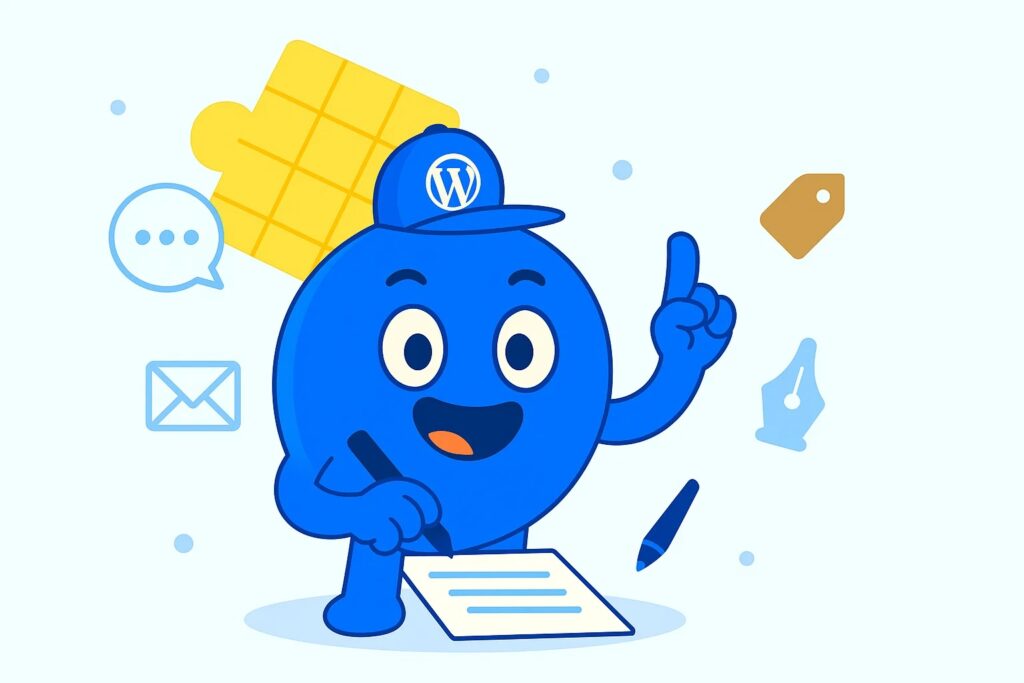
Beyond technical SEO, creating valuable and engaging content is a cornerstone of driving organic traffic and building a reputable brand. Content marketing is not just about attracting visitors; it is about establishing credibility and fostering a connection with the audience.
Blogging for Business: Educating and Engaging Your Audience
Starting a blog is one of the most effective ways to improve a store’s SEO and significantly increase traffic. By consistently creating valuable content around a niche and related topics, a store increases its chances of ranking higher for targeted keywords. A blog serves as an educational platform, helping potential customers make informed buying decisions and, in turn, building industry authority and trust.
To maximize the impact of blogging, it is important to optimize blog posts with relevant keywords strategically placed in title tags, meta descriptions, headings, and internal links. Regularly updating older content is also beneficial, as search engines favor fresh and updated material. Consistency in publishing is key; aiming to post at least three blogs a week, if daily posting is not feasible, can help maintain momentum.
Content marketing, when executed thoughtfully, functions as a full-funnel strategy. It extends far beyond simply ranking for keywords; it is about building a relationship with potential customers at every stage of their journey, from initial problem awareness to the final purchase.
For example, blog posts that answer common questions, such as “How do I keep my dog active in the winter?“, can effectively attract leads who are searching for solutions, naturally leading them to discover related products. To nurture these leads, offering valuable content like eBooks or free guides in exchange for email addresses (similar to Godin Guitars providing free guitar lessons) can keep subscribers engaged and informed, building trust until they are ready to buy.
Beyond the Blog: Videos, Guides, and User-Generated Content
Diversifying content formats is crucial for reaching a wider audience and enhancing engagement. Beyond traditional blog posts, valuable content can take many forms, including audiobooks, checklists, courses, eBooks, infographics, podcasts, reports, tutorials, webinars, and especially videos. Video content is particularly powerful, with the potential to increase user retention rates by as much as 95%.
A highly effective and authentic content strategy involves leveraging User-Generated Content (UGC). This includes encouraging customer reviews, testimonials, and unboxing videos. Running contests or giveaways can be a great way to incentivize the creation of more UGC, and featuring customer content prominently on a website and social media channels further builds trust and authenticity. User-generated content is inherently more trustworthy to potential buyers because it comes from peers rather than directly from the brand. It acts as potent social proof and can be a more cost-effective way to generate engaging material compared to producing all content in-house. This approach suggests a shift from purely brand-centric content creation to a community-driven content amplification model, fostering deeper loyalty and authenticity.
Regardless of the format, always prioritize high-quality content. This means using professional imagery, investing in good equipment, conducting thorough research and fact-checking, and utilizing professional editing software for photos, videos, and audio.
Spreading the Word: Leveraging Social Sharing
Social media has become an indispensable tool for WooCommerce store owners looking to expand their reach and boost sales. While social signals (likes, shares, comments) are not a direct SEO ranking factor, they significantly drive organic traffic and increase content visibility by exposing it to new audiences.
Making Sharing Easy: The Magic of Floating Buttons

To truly amplify content’s reach, it must be effortless for visitors to share. This is where tools like the Floating Awesome Button (FAB) WordPress plugin prove invaluable. FAB adds visible, custom floating buttons that remain accessible as visitors scroll down a page, encouraging them to take action. It simplifies crucial actions such as contacting the store, signing up for newsletters, or returning to the top of the page, ultimately turning passive visitors into active customers.
How FAB’s Social Sharing Transforms Engagement
The Floating Awesome Button makes a website more friendly and inviting by allowing the addition of beautiful floating buttons that connect visitors with their favorite social media applications. This functionality is specifically designed to help online communities grow by providing new and intuitive ways for people to interact with the site and its content. The plugin supports a wide array of social media and communication platforms, including Facebook Share, Twitter Share, Pinterest, WhatsApp, and many others. Additionally, it provides a dedicated Social Sharing Gutenberg block, making it remarkably easy to integrate share buttons directly within content, thereby boosting post-level engagement and making sharing effortless for visitors.
Consider this scenario:
- Before: A visitor genuinely loves a recent blog post or product but has to actively search for a tiny, static share button, or, even worse, manually copy and paste the URL. This friction often leads to distraction or abandonment, severely limiting the content’s organic reach.
- After (with Floating Awesome Button): The visitor finishes reading, and a prominent, beautifully designed floating button for their preferred social media platform is readily available. With a single, intuitive click, the content is instantly amplified to their network, bringing new, warm traffic back to the WooCommerce store. This transforms passive readers into active brand advocates, effortlessly extending the brand’s reach and attracting new, highly relevant visitors.
This ease of social sharing acts as a powerful force multiplier for organic reach and brand advocacy. While content creation and SEO efforts bring initial traffic, the real leverage comes from enabling frictionless sharing. By making sharing effortless, a business empowers its audience to become organic marketers, capitalizing on the power of trusted peer recommendations. This transforms passive content consumption into active advocacy, significantly amplifying content’s reach and attracting new, highly relevant traffic.
Table 3: Floating Awesome Button: Social Sharing Features & Benefits
| Feature | Benefit for Your WooCommerce Store |
| Unlimited Custom Floating Action Buttons | Create tailored calls-to-action for any page or product, enhancing user interaction. |
| Extensive Icon Support (1500+ icons) | Choose visually appealing icons that match your brand and clearly convey button purpose. |
| Multiple Button Positions (Left, Center, Right) | Place buttons strategically for maximum visibility and user engagement without obstructing content. |
| Multiple Button Shapes (10+ options) | Customize the look and feel of your buttons to align with your brand’s aesthetic. |
| Wide Array of Social Media & Communication Platforms (Facebook Share, Twitter Share, Pinterest, WhatsApp, etc.) | Connect with your audience on their preferred platforms, making sharing effortless. |
| Social Sharing Gutenberg Block | Easily integrate share buttons directly into your content, boosting post-level engagement. |
| Dynamic Content Placeholders | Personalize messages (e.g., WhatsApp) with current page info, enhancing relevance and engagement. |
| Overall User-Friendliness & Engagement | Simplifies user actions, encouraging more interactions and turning visitors into customers. |
| Amplified Organic Reach | Effortlessly enables visitors to share your content, extending your brand’s reach organically. |
| Growth of Online Community | Fosters interaction and connection with your audience across social channels. |
Chapter 2: Accelerating Growth: Paid Traffic Strategies

While organic strategies build long-term authority, paid traffic offers immediate visibility and highly targeted reach, allowing a business to place its products directly in front of potential customers.
Smart Advertising: Getting Your Products Seen
Paid advertising provides the ability to precisely target specific demographics and interests, making it highly effective for generating an impressive return on investment (ROI).
Google Shopping: These campaigns are exceptionally effective for product-focused businesses, achieving a remarkable 76% higher click-through rate (CTR) compared to standard text ads. To maximize their impact, focus on precise keyword targeting using tools like Google’s Keyword Planner. Incorporating promotional extensions, such as discounts or free shipping, can further boost CTR by up to 10%.
Social Media Ads (Facebook, Instagram, YouTube): Social media platforms are powerful channels for product discovery, with over half of consumers using them for product research. Content should be tailored for each platform; for instance, visual content on Instagram typically receives 25% more engagement, and video content on YouTube can increase user retention by 95%. Leveraging Facebook Custom Audiences can lead to conversion rates up to 10 times higher, while Instagram Shopping Ads have been shown to increase conversions by 20-30%. Always prioritize high-quality images and ensure products are tagged effectively in posts and stories.
Urgency Tactics: Incorporating a sense of urgency into promotions can significantly boost conversions. Strategies like countdown timers or limited-time offers can increase conversion rates by as much as 40%.
Bringing Them Back: The Power of Retargeting
Retargeting, also known as remarketing, is a highly effective strategy for re-engaging visitors who have previously interacted with a website but did not complete a purchase. These individuals are significantly more likely to convert—up to 70% more likely to make a purchase—because they have already shown interest in the products.
Implementing personalized campaigns specifically for abandoned carts can re-engage 10-30% of potential buyers. This involves crafting tailored messages that remind users of the products they viewed or left in their cart, often accompanied by incentives such as discounts or free shipping, as shipping costs are a primary reason for cart abandonment.
Acquiring new traffic is generally more expensive than re-engaging existing interest. The high conversion rates associated with retargeting highlight that this strategy is not just about recovering lost sales; it is about maximizing the value of the initial traffic investment. By targeting users who have already demonstrated intent, marketing efforts are focused on a “warm” audience, implying a more efficient use of the marketing budget and a higher return on investment compared to purely cold outreach.
Collaborate to Conquer: Influencer and Affiliate Marketing
In an increasingly crowded digital landscape, leveraging the credibility of others can be a game-changer for driving traffic and sales.
Influencer Marketing: Partnering with influencers in a niche allows a business to tap into their established audience and credibility. Influencer marketing can yield a high return on investment, with an average of $5.78 for every dollar spent, and can drive conversion rates up to 10 times higher than traditional advertisements. Micro-influencers, who have smaller but highly engaged and authentic followings, can be particularly cost-effective for targeted campaigns.
Affiliate Marketing: Participating in affiliate marketing programs involves third-party publishers promoting products in exchange for a commission on sales they generate. Research indicates that customers acquired through affiliate channels tend to spend 18% more than those from other sources. This is a budget-friendly, performance-based strategy where a business only pays when a sale actually occurs, making it a win-win for both parties.
In an age characterized by ad fatigue, consumers increasingly place their trust in recommendations from peers or respected figures rather than direct brand messaging. Influencer and affiliate marketing strategies capitalize on this by leveraging existing relationships and established credibility. The impressive ROI and conversion rates associated with these methods suggest that this approach is not merely a marketing tactic but a strategic way for small businesses to forge genuine connections and access niche audiences that might otherwise be difficult or expensive to reach through less personal advertising channels.
Table 1: Digital Marketing Channel ROI Comparison for Small Businesses
| Marketing Channel | Average ROI / Key Metrics | Effort/Time to See Results | Key Benefits for WooCommerce |
| SEO / Organic Traffic | Dominates ROI, no per-click cost. Low-cost, lasting results. | Long-term (6-12 months for significant ROI). Requires constant attention. | Broad reach, builds brand credibility & authority, full-funnel impact. |
| Email Marketing | Avg. $44 for every $1 spent , $36 for every $1 spent. Up to 3600% ROI. | Direct, cost-effective, measurable. | High personalization, high conversion rates, builds customer loyalty & retention. |
| PPC (Pay-Per-Click) / SEM | Avg. $2 for every $1 spent. Bing Ads can be 20% lower CPC than Google Ads. | Immediate visibility. | Advanced targeting options, quick results, captures high commercial intent. |
| Social Media Marketing (Organic) | Drives organic traffic, increases content visibility. | Requires consistent engagement. | Brand awareness, community building, product research. |
| Content Marketing | Avg. 16% ROI. | Builds trust & authority over time. | Establishes industry authority, nurtures leads, supports SEO. |
| Influencer Marketing | Avg. $5.78 for every $1 spent. Drives 10x higher conversions. | Cost-effective with micro-influencers. | High conversion rates, leverages trust & authenticity, niche audience reach. |
| Affiliate Marketing | Affiliate-driven customers spend 18% more. | Performance-based (only pay on sale). | Drives additional traffic, cost-effective, expands reach through partners. |
Part 2: Building Lasting Relationships (Customer Retention)
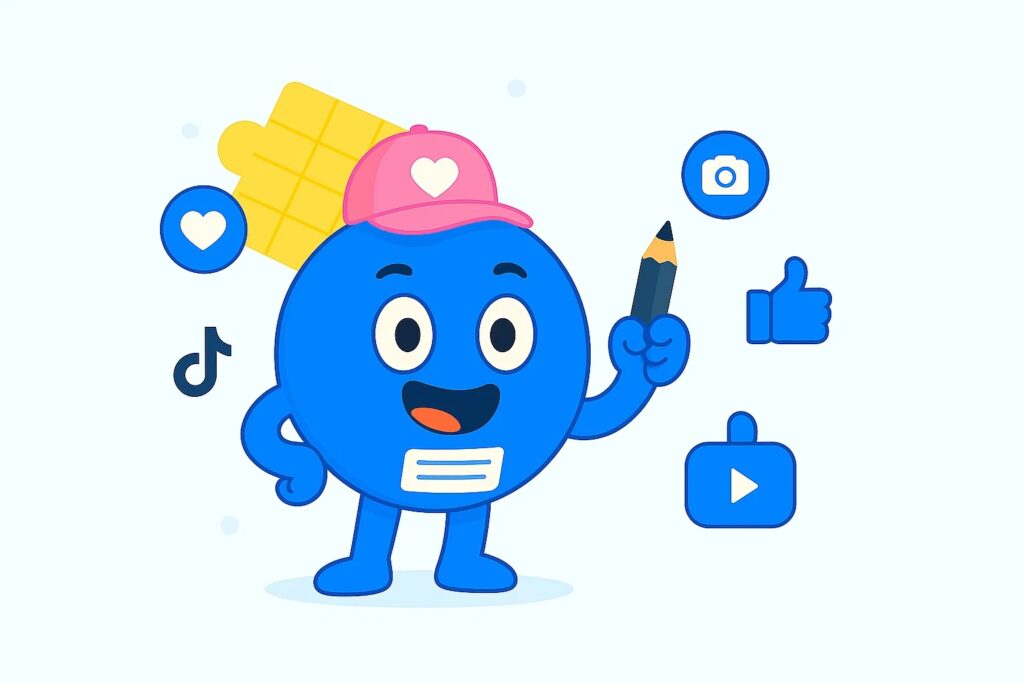
Acquiring new customers is important, but retaining existing ones is often more cost-effective and drives long-term business success. Cultivating loyalty transforms buyers into advocates, creating a sustainable growth engine for any WooCommerce store.
Chapter 4: Cultivating Loyalty: Turning Buyers into Advocates
Rewarding Engagement: Loyalty Programs That Work
Retaining existing customers is significantly more cost-effective than acquiring new ones. Loyalty programs are a proven method to increase sales, with members showing a 60% higher chance of making another purchase and generating 5 to 10 times more revenue than non-members. These programs are a strategic investment in Customer Lifetime Value (CLV) and organic growth, transforming customers into brand advocates.
Various types of loyalty programs can be implemented:
- Points Program: Customers earn points for their purchases (e.g., 1 point for every dollar spent) which can then be redeemed for discounts on future purchases. This model is ideal for businesses where customers make frequent, smaller-value purchases, such as retail stores or coffee shops. Examples include Starbucks Rewards and DSW’s VIP program.
- Tiered Program: In this model, customers unlock different perks and rewards as they spend more and move up through various tiers. Nordstrom’s “The Nordy Club” is a notable example, offering increasing benefits based on annual spending. This type of program is best suited for businesses with frequent, high-value purchases, like luxury goods or airline frequent flyer programs.
- Referral Program: This program rewards both the referrer (existing customer) and the new customer when a successful referral leads to a purchase. This is a particularly budget-friendly way to spread word-of-mouth marketing, as a business only pays when a sale occurs.
- Subscription Program: Customers pay a recurring fee to gain access to exclusive benefits, such as enhanced shipping options or discounts. Amazon Prime is a well-known example of a benefits-oriented subscription loyalty program.
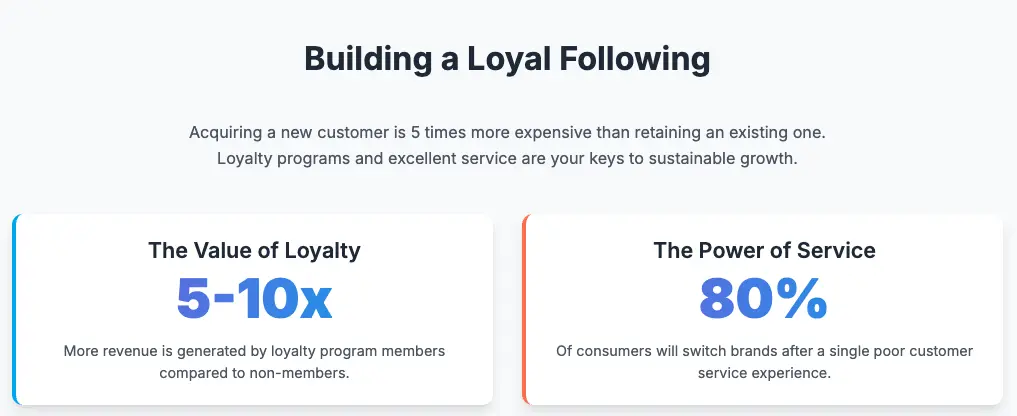
To effectively promote a loyalty program, businesses should create a dedicated “Rewards” page on their website, add banners to thank you pages and order confirmation emails, send welcome emails to new members, and consistently promote the program on social media.
The statistics clearly demonstrate that loyalty programs are not just about offering discounts; they are powerful drivers of Customer Lifetime Value. Furthermore, referral programs empower loyal customers to become organic marketers. This suggests that the cost of rewards is an investment in long-term, compounding growth, where satisfied customers not only make repeat purchases but also bring in new, trusted leads, making retention a key acquisition strategy.
Exceptional Service: The Foundation of Repeat Business
Exceptional customer support is a cornerstone of building lasting customer relationships and directly impacts sales and retention. It leads to high customer satisfaction rates (70% or higher), which in turn reinforces loyalty and encourages valuable word-of-mouth referrals. Conversely, a significant 80% of consumers report switching brands due to a perceived lack of support. This highlights that customer service acts as a powerful competitive differentiator.
Key aspects of providing exceptional service include:
- Responsiveness: Reducing response times is crucial. Aiming for under 24 hours for first responses to inquiries can positively impact satisfaction.
- Flexibility: Maintaining flexible return and refund policies builds trust and reduces customer apprehension.
- Instant Support: Providing instant support throughout the customer journey, perhaps through chatbots or live chat, creates a positive experience and increases the likelihood of customers choosing a store over competitors.
- Transparency: Consistent and transparent communication regarding policies, pricing, and order status builds trust and prevents unexpected surprises that can drive customers away.
- Professionalism: Addressing negative feedback professionally and constructively demonstrates a commitment to customer satisfaction and can turn a potentially negative experience into an opportunity to build loyalty.
In a crowded e-commerce landscape, product differentiation alone is often insufficient. This indicates that exceptional customer service is not just about problem-solving; it is about building emotional connections and transforming potentially negative experiences into opportunities for fostering loyalty. For small businesses, this can be a powerful, cost-effective competitive advantage that cultivates strong brand advocacy and positive word-of-mouth marketing.
Listening and Learning: Leveraging Customer Feedback
Actively seeking, collecting, and acting on customer feedback is vital for continuous improvement and fostering a strong sense of community. Companies that genuinely act on feedback observe a significant 30% improvement in customer satisfaction. This process transforms customers from passive consumers into active participants in a brand’s evolution.
Effective methods for collecting feedback include:
- Surveys and Reviews: Tracking feedback through surveys and reviews provides invaluable data that can directly shape product offerings and service improvements.
- Online Communities: Engaging with customers in online communities or dedicated forums helps build a sense of belonging and makes customers feel valued and significant.
Crucially, acting on feedback demonstrates that customer opinions are valued. When existing customers see their feedback acknowledged and, in some cases, featured (as in user-generated content), it reinforces their connection with the brand, encouraging repeat engagement and future purchases.
This suggests that a robust feedback loop turns customers into active contributors to a brand’s success. By actively listening, implementing suggestions, and featuring customer contributions, businesses can build a stronger, more engaged community, leading to deeper loyalty and advocacy that fuels organic growth.
Conclusion: Your Path to E-commerce Success
The journey to driving traffic and boosting sales for a WooCommerce store involves a multi-faceted approach, encompassing both attracting new visitors and converting them into loyal customers. This article has explored a comprehensive roadmap that includes mastering organic traffic through strategic SEO and compelling content, accelerating growth with intelligent paid advertising, optimizing the store for seamless conversions, and cultivating lasting loyalty through exceptional service and rewarding engagement.
E-commerce success is not a static destination but an ongoing journey of learning, adaptation, and optimization. The digital landscape is in constant flux, with evolving algorithms, new technologies, and shifting customer preferences. Therefore, continuous monitoring of sales, customer behavior, and website analytics is paramount.
Regularly evaluating and revising strategies , and maintaining a willingness to test new approaches—from headlines to calls to action—is essential. This iterative process ensures that a business remains agile and responsive to market changes. The repeated emphasis on monitoring, analyzing, and testing throughout these strategies reveals a critical underlying principle: e-commerce is a dynamic, not static, endeavor.
Sustained success stems from a continuous cycle of data collection, analysis, and strategic adjustment. This empowers business owners by framing challenges as opportunities for learning and optimization, fostering a mindset of perpetual improvement.
Every successful WooCommerce store began with initial steps and consistent effort. By diligently applying these strategies, maintaining a strong focus on customer needs, and embracing continuous improvement, any online business is well on its way to unlocking its full potential and achieving remarkable success in the competitive e-commerce world.


